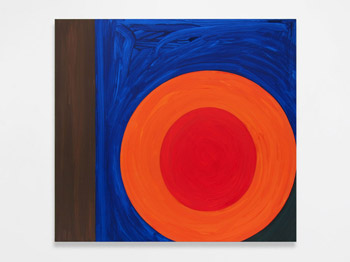Claude Closky
Laloli
4 September – 16 October 2010
Opening:
4 September, from 6 to 9 p.m.
5, rue du grenier Saint-Lazare
75003 Paris, France
+33 (0)1 42 71 10 66
Claude Closky usually removes signs from their customary circulation, isolates them, or slows them down in an operation of detachment which scales down the sense, regulates the flow as low as possible, like a raw material which he transforms but not transfigures. Recourse to “untitled” when Closky produces canvases indicates a threshold, where painting mobilizes a particular status of language in art, and in his work especially. The paint itself suspends the content and diverts it towards a misleading modernism, a false abstraction. The financial curves and graphs of the previous series have lost their abscissa and ordinates, and language is nominally summoned to say nothing. Closky makes the painting a surface that blocks meaning, all at once a plane of separation and materialization, and a space of tension between irreconcilable poles.
Holding back meaning is not so simple. These compositions are linked with the tradition of the opaqueness of signs as opposed to the transparency we sometimes supposed they have: the inscription takes precedence over what it conveys. Closky also practices montage with paper collages which expose their main operation: cutting. In the collages of syllables on view here (Lalolilu, etc.) he has taken bits of words printed in newspapers, and put them back together based on a new rule. The terms that result therefrom are devoid of meaning. In the pictures, the syllables — a consonant and a vowel – have been disjointed by the distribution of colours on surfaces forming letters and background. Our reading is upset, objectless. Nor do we instantly recognize the standardized naturalism of the colours which belong to the vocabulary of the landscape: green field, blue sky, black tunnel, yellow sun, and so on. Landscape and onomatopoeia have no kinship, and the pictures bring them together without unifying them. The outcome is disconcerting and not very spectacular — enigmatic and common-or-garden, just like life.
(…) The rough-and-ready dismantlement of the printing characters and the descriptive codes of the colour co-exist. The surface of the picture brings them together without muddling them, well removed from any traditional symbolic operation which might be based on the promise of a reconstitution. Words and texts are absent, nature is faraway. Closky represents the dissociation of signs and meaning with the same signs which have the task of adjusting meaning. As for the picture he makes of it, there is no description to take its place. “The fact is that the image is not defined by the sublimeness of its content but by its form, i.e. through its “inner tension”, or by the strength it galvanizes to make a void or make holes, loosen the grip of words, dry the oozing of voices, and become separate from memory and reason […]. Gilles Deleuze, “L’Epuisé”, postface to Samuel Beckett’s Quad, Minuit, 1992.
Extract from Untitled, Image, Marie Muracciole.
[Translated by Simon Pleasance & Fronza Woods]
